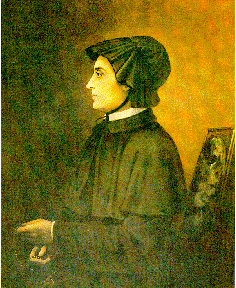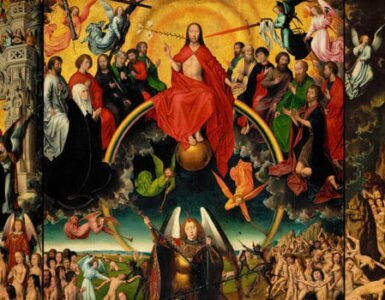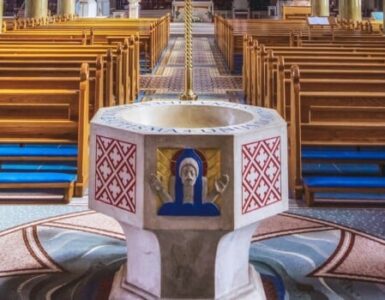Is the term “restless monk and famous Catholic personality” an oxymoron? Perhaps, but it is also an accurate description of Father Louis, OCSO, or, as he is usually known, Thomas Merton. The Trappist Merton (1915-1968) is one of the best-known Catholic converts of the mid-twentieth century. The story of Merton’s life before his conversion reveals someone with an unstructured upbringing who began searching for truth amidst the allurements of the world. His post-conversion story shows a man never quite at ease in the monastic life and still wrestling with both his heart and developments outside the cloister. Who was this restless man?
Perhaps one cause of his restlessness was a lack of roots. Merton was born in France to two artists: an American mother and a father from New Zealand. His mother died when he was six and his younger brother not yet three. The brothers grew up in various places, spending considerable time with grandparents on Long Island. Thomas had some exposure to religion but it was not an enduring faith. His father died while Thomas was in his teens, and his maternal grandparents set up financial arrangements and a guardian for the young man.
Like his living situations, Merton’s education was eclectic. He was a student in both France and England, always an outsider. After some travels, he began university studies at Cambridge in 1933, but only lasted a year there. He then went to the U.S. and began a successful academic stint at Columbia University, majoring in English and later doing graduate studies. He was also writing poetry and other work during that time.
It was in New York City that Merton was seriously attracted to Catholicism. This attraction was reinforced by his university studies and reading of authors such as the French Catholic philosopher Etienne Gilson. He also grappled with Catholic thinkers like St. Thomas Aquinas in some of his classes. In November 1938, he was baptized and received into the Church. Ever restless, he began wondering what his next steps would be as a serious and committed believer.
After obtaining an M.A. from Columbia, he took the job at St. Bonaventure, a Franciscan institution. There he was able to live near and work with Catholic religious, and made a stab at entering the Franciscan order. However, he was asked to withdraw his application after revealing he had fathered a child while living in England. By that time (1940), World War II was raging in Europe. Merton, facing the draft, registered as a conscientious objector willing to do duty as a medic, but he was classified a sub-optimal 1B due to his poor teeth. Meanwhile, he considered another religious order, the Trappists. After a retreat at the Abbey of Gethsemani in Kentucky, Merton returned to his teaching duties. But he also came under the influence of two Catholic women: St. Therese of Lisieux, and the activist Catherine de Hueck (Doherty). He spent some time at de Hueck’s Friendship House in Harlem, but the consecrated religious life kept calling, and in December 1941, as the United States was entering the war, Merton found refuge at Gethsemani, beginning a new chapter in his restless life.
Instead of putting writing behind him, Merton (Brother Louis) was asked to do some translations and writings in the service of the Cistercians. Then came an exercise in notoriety: with his superior’s encouragement, Brother Louis wrote the book that made him famous, keeping him from the anonymity usually associated with monasticism. The Seven Storey Mountain was published in 1948, quickly becoming a best-seller. Merton became Father Louis in 1949 when he was ordained a priest. His books kept coming, and as the decades rolled on, Merton became somewhat of an icon to pacifist and activist Catholics. In a sense, his innate restlessness was in-sync with the agitated 1960s. He clashed with his superiors. He wrote about the Vietnam War and race relations. And he explored Buddhism and non-Christian monasticism. He even, in the midst of an emotional entanglement with a woman who had nursed him during a hospital stay, considered marriage. In 1968 he toured Asia before speaking at an interfaith conference on monasticism in Thailand. On December 10, he was found dead in his room, victim of an accidental electrocution. He was restless no more.
In the prologue to his 1955 book No Man Is an Island, Merton makes an ambivalent declaration: “I do not intend to divorce myself at any point from Catholic tradition. But neither do I intend to accept points of that tradition blindly, and without understanding, and without making them really my own” (13). In the book’s first chapter, he follows up on that point by writing, “there can never be happiness in compulsion” (25). By his own words we get a glimpse into Merton’s restless, even rebellious, spirit.
What to read: Merton was a prolific author, and over the course of his life he wandered from writing about Catholic monastic practice and tradition into social justice and non-Catholic religion, especially Buddhism. For advice on discerning which of his books to read and which to avoid, Dan Burke at Catholic site SpiritualDirection.com offers a two-part introduction to the matter (here, and here). The one Merton book considered a spiritual classic by many is The Seven Storey Mountain about his family, early life, conversion, and flight into the monastery. On the question of what to read about Thomas Merton…there is an entire horde of books, but it should be avoided. Many heterodox or non-Catholic writers have appropriated Merton for their own agendas, especially in his writings on Buddhism. Nonetheless, there are two books which can be recommended on Merton’s life and work. Both are appreciative of his work but critical of his failings. The Life You Save May Be Your Own: An American Pilgrimage by Paul Elie situates Merton in the context of twentieth century American Catholicism and its major writers. It also covers Flannery O’Connor, Dorothy Day, and Walker Percy. Elie especially focuses on Merton the writer. The second is a biography, Living With Wisdom: A Life of Thomas Merton by Jim Forest. Forest, a one-time member of the Catholic Worker, knew Merton in the 1960s, and this well-illustrated book gives a warts-and-all account of Merton’s life.
Thomas Merton was a gifted writer, a monk, a priest, and a public figure. Those roles did not co-exist well. Even while living in a hermitage at Gethsemani, he also had a record player and an active correspondence with others in the world. Bishop Robert Barron praises Merton as “one of the greatest spiritual writers of the twentieth century.” That may be true, but an honest look at Merton’s life also shows the dangers of losing track of one’s vocation.
✠












